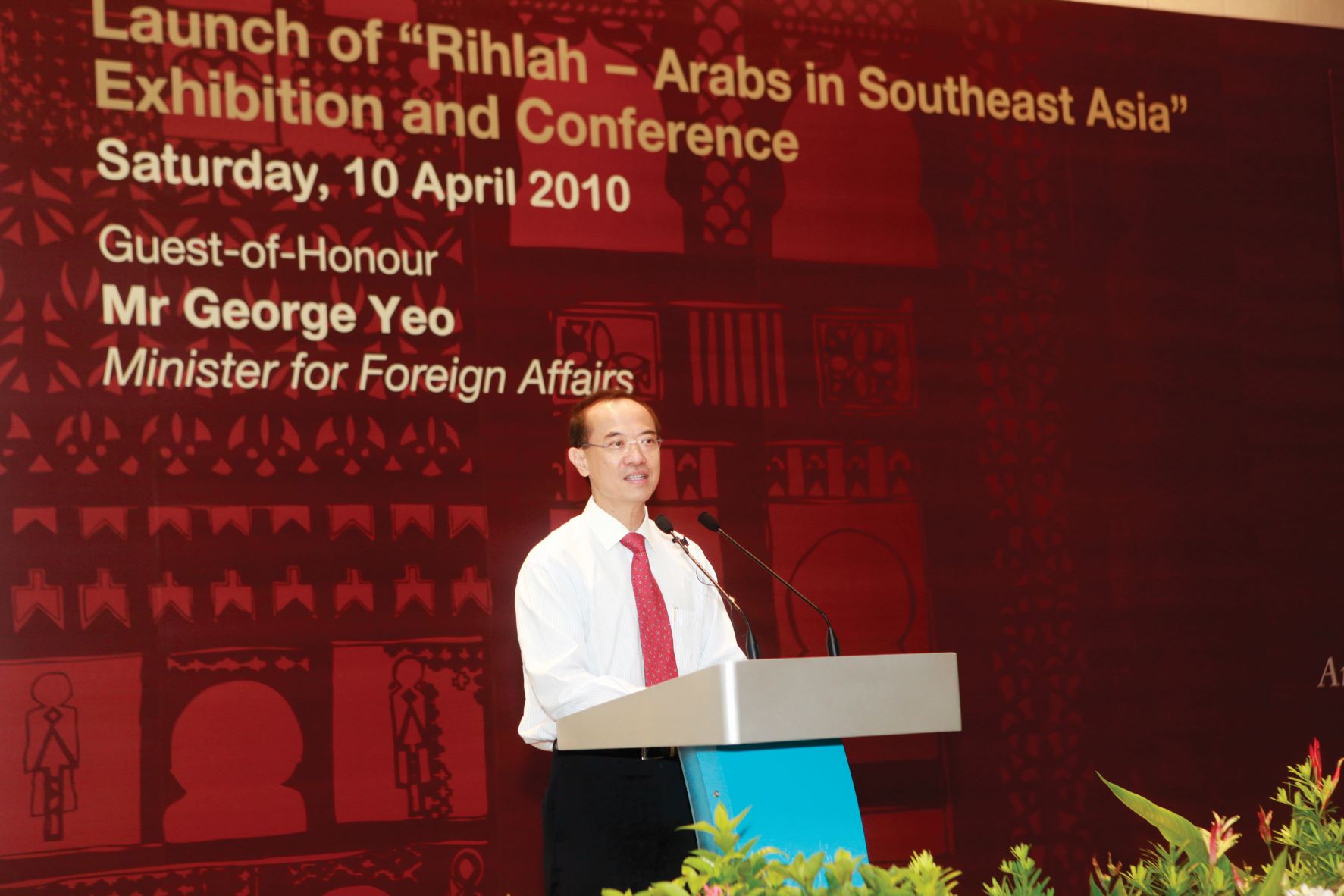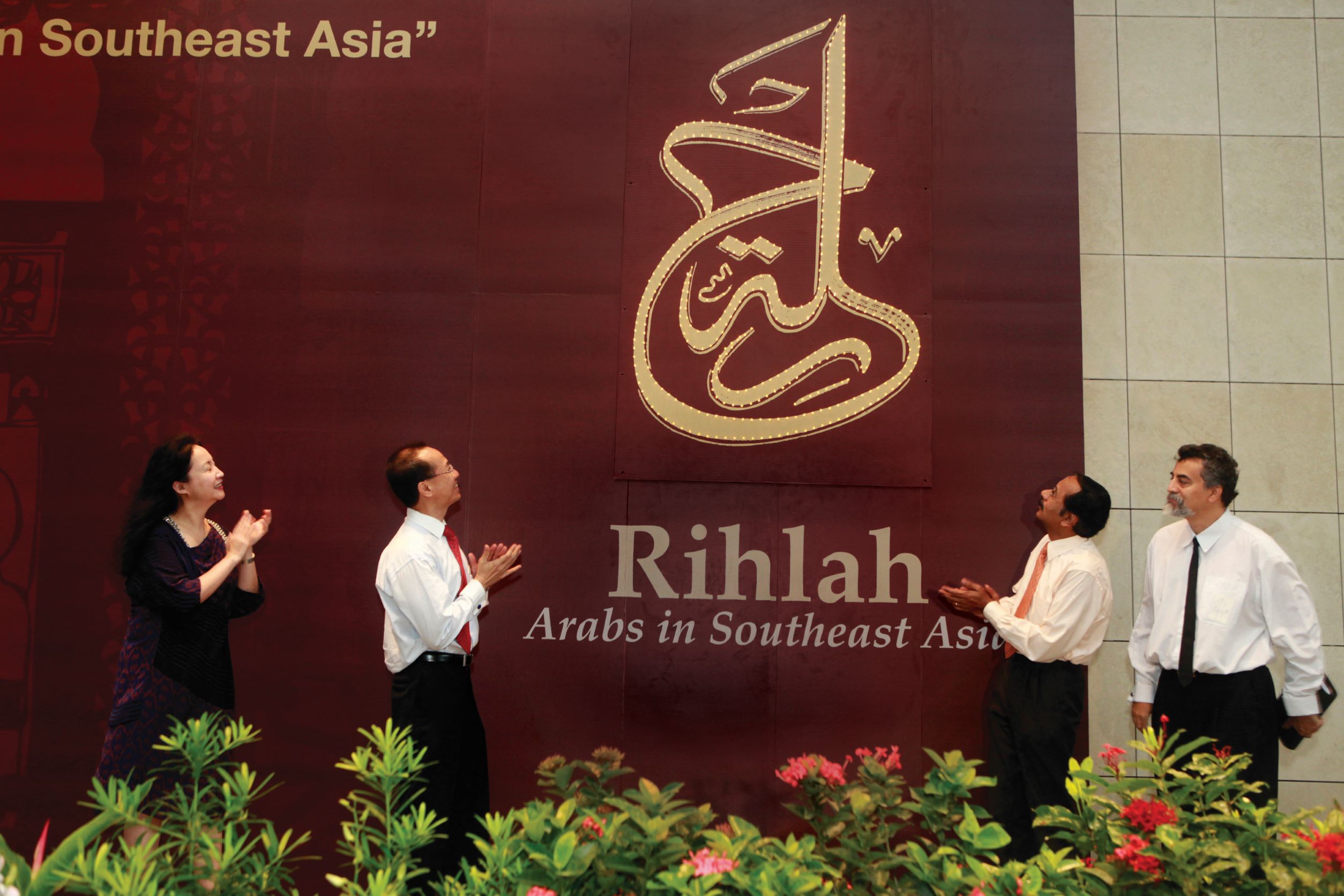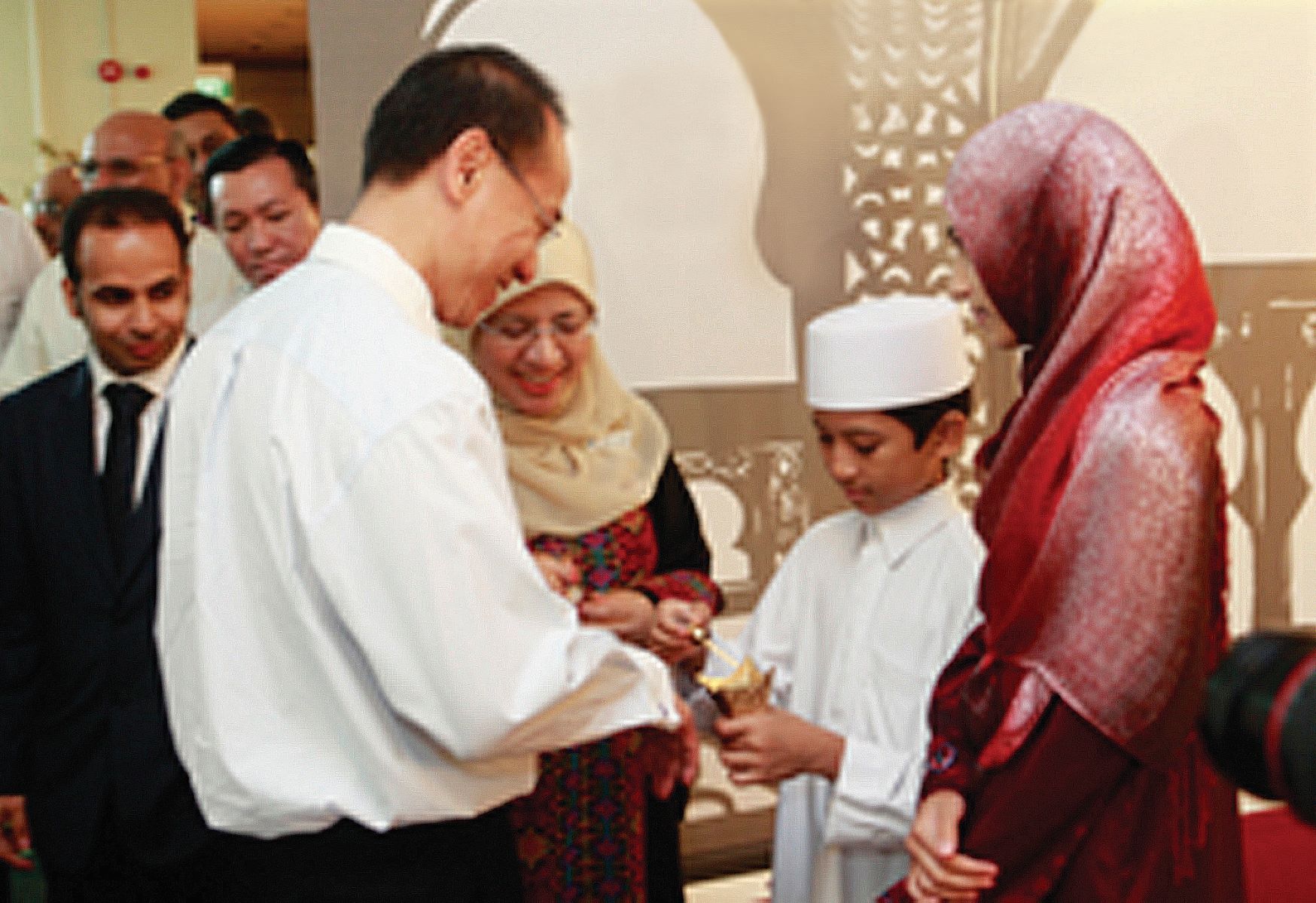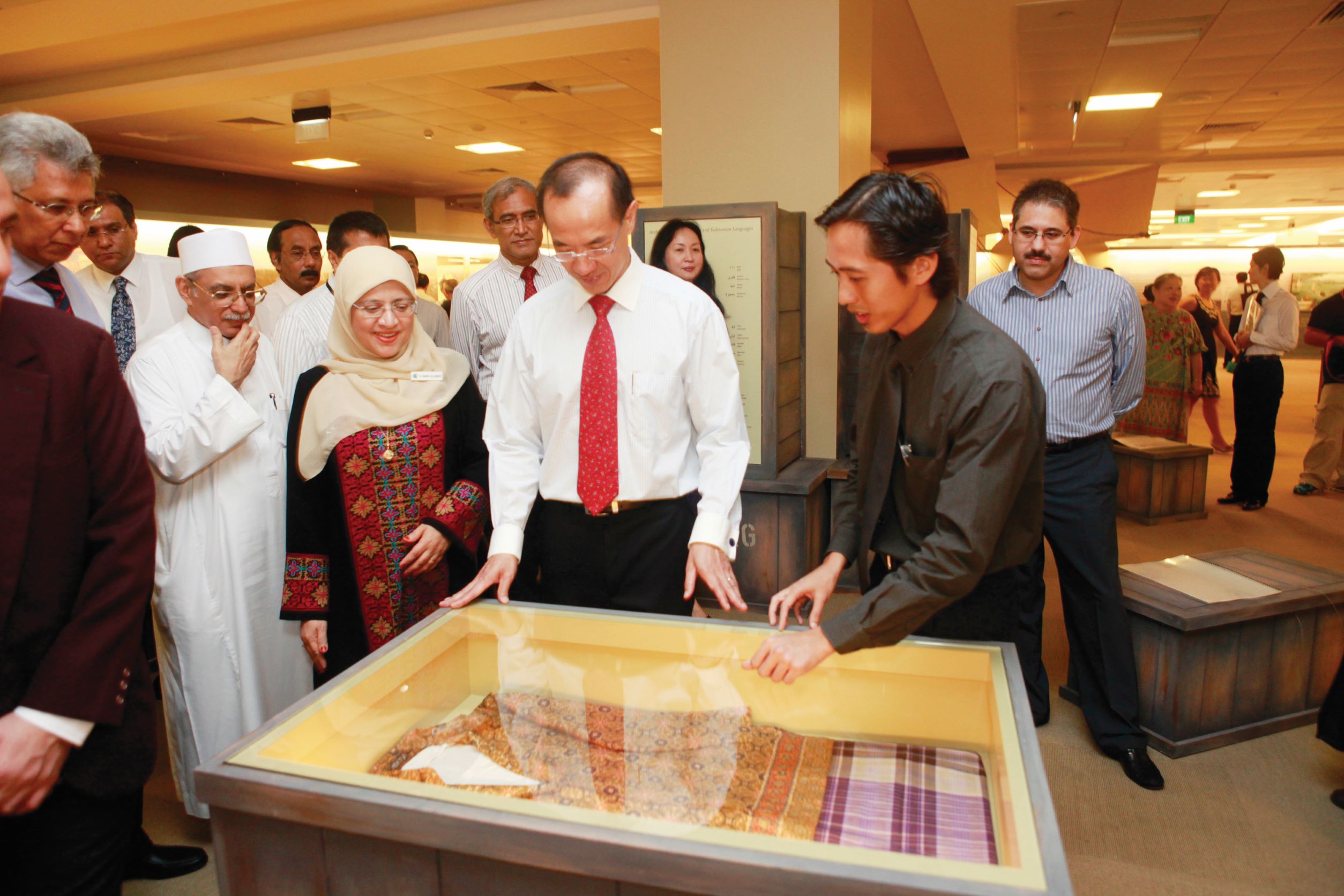Journey: A Story About the Past and Future
An edited transcript of Minister George Yeo’s opening speech at the launch of the exhibition and conference “Rihlah – Arabs in Southeast Asia” held on 10 April 2010.

Good morning, dear friends. I am delighted to be here to join all of you for the launch of an exhibition and a conference on the Arabs in Southeast Asia. In fact, I have been looking forward to it. The theme is Rihlah – “Journey”. This is a story, not only about the past, but also about the future.

Dr N. Varaprasad (Chief Executive, National Library Board) talked about the Omani dhow, which is setting sail from Cochin to Singapore this weekend. It set sail from Muscat in mid-February – a replica of an ancient dhow, which sank about 500 miles to the south of Singapore, near Belitung, in shallow waters and so quickly got covered and protected by sand. On board, there were over sixty thousand pieces of porcelain from many kilns in China, mostly Changsha. The motifs were Chinese, Buddhist, Taoist, central Asian, Arabic, because that was the Age of Tang, of Buddhist Sriwijaya, of Nalanda, of the Abbasids.
In mid-March, it arrived in Cochin. As it approached the continental shelf, a big green turtle appeared alongside. For those of you who are not familiar with the journey of the Jewel of Muscat, which was a gift from Sultan Qaboos to us, I recommend their website to you, because they give regular updates about the re-enactment of an ancient voyage – when there were no engines, when they depended only on their sails and the trade winds. And it is no wonder that the Malays have always called this region “Tanah di Bawah Angin” (Land Under the Wind). Because it was the trade winds which made possible the maritime Silk Road.
Throughout history, different groups have been plying this coastline, from Europe, all the way to China and Japan, to pre-Islamic days – in fact, probably to the beginning of history, when the sea was the original Internet, linking people together. It is a story about the Arabs, it is a story about the Indians, the Malabaris and the Cholas. It is the story about Bugis and Acehnese peoples, a story about the southern Chinese, about the Chettiar merchants, about Koreans and Japanese. And in this century, this story will be retold in a much bigger way.
A few years ago, we celebrated the 600th anniversary of the first voyage of the Ming admiral, Zheng He, himself a Muslim eunuch, who travelled all the way to the Hejaz, and went to Mecca. Each can tell the story from a different perspective, and each has learnt from the other in ways that they sometimes are less conscious of themselves. I spoke to the MFA (Ministry of Foreign Affairs) officer who was on the Jewel of Muscat, and he told me that when they arrived in Cochin, what they saw first were the Chinese fishing nets. And along the Malabari coast, there are many things in their kitchen, in their daily lives, which they ascribe to what they have learnt from China. And Zheng He’s own voyages to the Indian Ocean would not have been possible without knowledge he had gleaned from the Arabs, about conditions in that part of the world, and tricks in navigation.

When Raffles came to Singapore, Singapore was his second best choice. During the Napoleonic wars, the British had occupied Java, and he stayed there for five years. He was a great scholar, and he saw that in every major Javanese town, there were Arabs communities that supported the trading networks. He told London that the British should never give up Java. But, with the Congress of Vienna, there was no choice. So he retreated to Calcutta, from where he plotted to establish an alternative base. When he founded Singapore in 1819, one of the first things he did was to persuade Hadhrami families to come here. Syed Mohammed Harun Aljunied and Syed Omar Aljunied from Palembang were given a warm welcome, and from that time on, Singapore became the centre of the Hadhrami network in Southeast Asia – a network which goes back a long time. But because Singapore was the trading hub, and the Hadhramis being trading people, this became their centre. And then Singapore’s own entanglement with the history of the Hadhramaut began.
I had the great pleasure of visiting the Hadhramaut in May 2007, with members of the Al-Wehdah, who are now here, and Dr Ho Engseng, who wrote the beautiful book, The Graves of Tarim. And I was so pleasantly surprised at how linked we are – historically, culturally, genetically, economically – to the Hadhramaut.
When we were at Seiyun, there was a historical house, a museum, and there were old pictures. And one of the pictures showed a Singapore Studebaker, an old car, which had been shipped to Mukalla, dismantled in Mukalla, backpacked on camels, brought to Tarim, and then reconstructed, complete with a Singapore “S” number plate. And of course, later, it was a Singapore Hadhrami, Alkaff, who financed the construction of the road from Mukalla to Tarim, a road which is still being used today. And it was at the Alkaff Mansion that Harold Ingram – whose daughter Dr N. Varaprasad acknowledged for her support of today’s event – worked out a peace agreement between the two contending houses, the Qua’itis and the Kathiris. And Harold and his wife Doreen were the first Europeans to live in the Hadhramaut. And I was just told by Dr Farid Alatas that Leila Ingram is right now in the Hadhramaut, continuing the research of her parents.
I remember the wonderful lunch hosted for me in Tarim by the Governor of Hadhramaut, who is the great-great-great-great-grand nephew of Syed Omar Aljunied, Syed Ahmed Janned Aljunied. I was sitting among relatives and friends, relatives of Habib Hassan, of our Mufti, and eating sambal belachan and flavours of food which we are completely familiar with. It is a land of batik and sarong. These connections are deep-rooted, and for some time, we thought they had disappeared. But they have not disappeared, because the roots are still there, and with the new spring, the plants are re-growing, re-flourishing. And this exhibition and convention is really about the story of that old connection and what it means for the future.
Since 2003, we decided in Singapore that it is in our own interest to alter our policy towards that part of the world, to revive it and to make it a part of our future. So you would have noticed in the last few years, an endless series of high-level visits between the two sides, between Singapore leaders and leaders of Arab countries, from the Maghreb, Egypt, Saudi Arabia, the Gulf, Syria, up and down.
And here in Singapore, there is an effort by the URA (Urban Redevelopment Authority) to revive the Arab quarter, to recover our Arabic roots to which the Hadhrami story is central. And the journey does not end here. This is not the terminal point. This is but the mid-point to China; and it has always been China who drove the East-West trade. A story of rise and fall of dynasties, leading to the ebbs and flows of the maritime trade. And this new flow is the biggest, most gargantuan ever.
In the wonderful new book written by Ben Simpfendorfer, Chief China Economist of the Royal Bank of Scotland – formerly he was with JP Morgan – the book is called The New Maritime Silk Road. And it begins by talking about a town in Zhejiang province, called Yiwu. And in that town are thousands of Arab companies, buying things from China, supplying to all parts of the Middle East. They are from Damascus, they are from Oman, they are of course as we expect, also from the Hadhramaut. And some of them have powerful links to Singapore.
China is rediscovering the Middle East, and the Middle East is rediscovering China. And once the trade links have re-established, as it happened once upon a time, with these trade links will also be re-established political and cultural links, and the re-mixing of blood. This re-mixing of blood is itself a fascinating story. I see here so many Hadhramis, so many with links to the Hadhramaut, with mixed blood, but who contributed hugely to the Hadhramaut and to keeping alive the many connections.
The first thing we did when we arrived in the Hadhramaut was to do the rituals, which Dr Ho Engseng described in his book. Which is, for a descendant of the prophet to say the prayers at the tomb of Syed Ahmad Isa, the Muhajir, their common ancestor, who arrived there from Basrah a thousand years ago – I think the seventh or the ninth descendant of the prophet. Syed Alwi [Aidid] – who has a Chinese mother – was a nervous wreck that day. I do not know whether he is here this morning. I could see that he was greatly stressed because all the weight of his ancestors was on his shoulders. But it was the beginning of an important ritual, which continues to be observed again and again. And which, in myriad different ways, connects different parts of the region together.
With the rise of China, with the re-emergence of India, Arab merchants will once again play an important role. But the story should not end with trade, even though is an important part of it, it should lead to better inter-cultural, inter-civilisational understanding.
I was leafing through a recent book written by Vali Nasr who had written a wonderful book called the The Shi’a Revival. His new book is called Forces of Fortune. And his main point is, to the Western audiences: “Do not equate Islam to extremism, to terrorism.” That cannot explain Islam’s legacy in the world. He said, look at the new middle classes, look at the new connections being made. He talked about Dubai, about the China Centre in Dubai, and about the new things that are happening. He recounted a beautiful episode when Pope Benedict, he decided, as a gesture of outreach to Muslims and to show understanding, to visit Turkey. When he was in Istanbul, he visited the Blue Mosque – which all of us know is a wonderful piece of architecture. As the Pope was leaving, his eye was drawn to the archway above the main exit, on it was white Arabic calligraphy against the black tableau – words he asked his interpreter to translate. The interpreter said it says “Al kasib habib Allah” – “The merchant is the beloved of God”.
Vali Nasr used this little episode to illustrate an aspect of Islam which we often forget, between the West and the Arab world, long centuries of conflict, which are in the historical memories of both sides. Arabs today still talk nostalgically of Al Andalusia, when Spain was Muslim. For the Iberian peoples, much of their national characters were forged in what they called the “Reconquista”, the centuries of recovering that peninsula back into Catholicism. And when they finally succeeded in 1492, they left the shores to conquer the world. And when the Portuguese came to this part of the world centuries ago, they could not separate their emotions from the local context at that point in time. It is a complicated problem; it will take time and a lot of effort to overcome. But here in our part of the world, the contact between Islam and non-Islamic Asia had been quite different, particularly the Arab contact. With the Turkic people; it is a different story in India.
But the Arabs who came here were mostly traders and religious teachers. And because they were traders, they wanted peace, they wanted diplomatic relations, they wanted trade routes to be opened. And they welcomed diversity because they saw in diversity opportunities. Unless we are diverse, why should we be trading? And sometimes the greater the diversity, the greater the trading opportunities. So we have an opportunity in Asia to tell a different story about Islam, very different from that story told from a Western perspective. And as the region rises, and as this story is told in fresh ways, I hope, maybe, that it will also have an influence on the way the West conducts its own relations with the world of Arabia, the world of Islam.

I think it is wonderful how the National Library Board, not just providing reference and lending services, has also taken upon itself the telling of stories, stories about different groups who have plied these waterways from the beginning of time, and whose activities are what makes Singapore what it is today. Thank you.
On public display for the first time are photographs and artefacts such as treasures from ancient shipwrecks in the region, to rare musical instruments and personal documents telling the story of the migrations of Arabs of Southeast Asia. Commentaries on the two publications released in conjunction with the exhibition are published on pages 24 and 31 of this issue.
We would like to thank S. Zahra Aljunied, Senior Librarian, National Library Board, for transcribing this speech.

